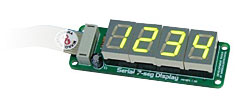PLEASE NOTE: This article is obsolete or related to a discontinued product.
Interfacing a 7-seg display module
This article illustrates how to interface the mikroElektronika Serial 7-seg display module to the FOX Board LX
|
The mikroElektronika Serial 7-seg display module is a 4 digit module based on a MAX7219 serial input/output common-cathode display drivers with a SPI serial interface.
As other mikroElektronika extra board this module has a 5x2 female connector to be connected with a main board. The signals available on this connector (CN1) are:
|

The mikroElektronika Serial 7-seg display module |
Wirings
The wirings between the FOX Board LX and the 7-seg module used in this example are:
J6.23 (OG1) --> CN1.1 (CS#)
J6.26 (OG3) --> CN1.4 (SCK)
J6.25 (OG4) --> CN1.6 (DIN)
J6.12 (+5VCC) --> CN1.9 (+5VCC)
J6.40 (GND) --> CN1.10 (GND)
Sample code in C
This is an example of code in C based on the original example provided by mikroElektronica:
/*
7seg.c
Sample of C code to use a mikroElektronika Serial 7-seg Display module
with the Acme Systems FOX Board LX.
http://www.acmesystems.it/?id=71
Based on the C example code provided by Mikroelektronika.
*/
#include "stdio.h"
#include "stdlib.h"
#include "unistd.h"
#include "sys/ioctl.h"
#include "fcntl.h"
#include "time.h"
#include "string.h"
#include "linux/gpio_syscalls.h"
#define CS_HI gpiosetbits(PORTG,PG1)
#define CS_LO gpioclearbits(PORTG,PG1)
#define SCK_HI gpiosetbits(PORTG,PG3)
#define SCK_LO gpioclearbits(PORTG,PG3)
#define DIN_HI gpiosetbits(PORTG,PG4)
#define DIN_LO gpioclearbits(PORTG,PG4)
void SPI_init(void) {
CS_HI;
SCK_LO;
DIN_LO;
}
void SPI_write(unsigned char value) {
int i;
for (i=7;i>=0;i--) {
if (value&(1<<i)) {
DIN_HI;
} else {
DIN_LO;
}
SCK_HI;
SCK_LO;
}
}
void max7219_init1() {
CS_LO;
SPI_write(0x09); // BCD mode for digit decoding
SPI_write(0x5F);
CS_HI;
CS_LO;
SPI_write(0x0A);
SPI_write(0x0F); // Segment luminosity intensity
CS_HI;
CS_LO;
SPI_write(0x0B);
SPI_write(0x07); // Display refresh
CS_HI;
CS_LO;
SPI_write(0x0C);
SPI_write(0x01); // Turn on the display
CS_HI;
CS_LO;
SPI_write(0x00);
SPI_write(0xFF); // No test
CS_HI;
}
void display_number(unsigned int data) {
CS_LO;
SPI_write(4); // send Thousands digit
SPI_write(data/1000);
CS_HI;
CS_LO;
SPI_write(3); // send Hundreds digit
SPI_write((data/100)%10);
CS_HI;
CS_LO;
SPI_write(2); // send Tens digit
SPI_write((data/10)%10);
CS_HI;
CS_LO;
SPI_write(1); // send Ones digit
SPI_write(data%10);
CS_HI;
}
int main(int argc, char **argv) {
int cnt;
SPI_init();
max7219_init1(); // initialize max7219
for (cnt=0;cnt<10000;cnt++) {
display_number(cnt);
usleep(1000);
}
return(0);
}
/*
7seg.c
Sample of C code to use a mikroElektronika Serial 7-seg Display module
with the Acme Systems FOX Board LX.
http://www.acmesystems.it/?id=71
Based on the C example code provided by Mikroelektronika.
*/
#include "stdio.h"
#include "stdlib.h"
#include "unistd.h"
#include "sys/ioctl.h"
#include "fcntl.h"
#include "time.h"
#include "string.h"
#include "linux/gpio_syscalls.h"
#define CS_HI gpiosetbits(PORTG,PG1)
#define CS_LO gpioclearbits(PORTG,PG1)
#define SCK_HI gpiosetbits(PORTG,PG3)
#define SCK_LO gpioclearbits(PORTG,PG3)
#define DIN_HI gpiosetbits(PORTG,PG4)
#define DIN_LO gpioclearbits(PORTG,PG4)
void SPI_init(void) {
CS_HI;
SCK_LO;
DIN_LO;
}
void SPI_write(unsigned char value) {
int i;
for (i=7;i>=0;i--) {
if (value&(1<<i)) {
DIN_HI;
} else {
DIN_LO;
}
SCK_HI;
SCK_LO;
}
}
void max7219_init1() {
CS_LO;
SPI_write(0x09); // BCD mode for digit decoding
SPI_write(0x5F);
CS_HI;
CS_LO;
SPI_write(0x0A);
SPI_write(0x0F); // Segment luminosity intensity
CS_HI;
CS_LO;
SPI_write(0x0B);
SPI_write(0x07); // Display refresh
CS_HI;
CS_LO;
SPI_write(0x0C);
SPI_write(0x01); // Turn on the display
CS_HI;
CS_LO;
SPI_write(0x00);
SPI_write(0xFF); // No test
CS_HI;
}
void display_number(unsigned int data) {
CS_LO;
SPI_write(4); // send Thousands digit
SPI_write(data/1000);
CS_HI;
CS_LO;
SPI_write(3); // send Hundreds digit
SPI_write((data/100)%10);
CS_HI;
CS_LO;
SPI_write(2); // send Tens digit
SPI_write((data/10)%10);
CS_HI;
CS_LO;
SPI_write(1); // send Ones digit
SPI_write(data%10);
CS_HI;
}
int main(int argc, char **argv) {
int cnt;
SPI_init();
max7219_init1(); // initialize max7219
for (cnt=0;cnt<10000;cnt++) {
display_number(cnt);
usleep(1000);
}
return(0);
}

Hand made prototype at work
Credits This article has written in cooperation with Tigal.com (http://www.tigal.com).
It is possible to buy the 7-seg display module directly from Tigal.com web site on:
http://www.tigal.com/prodotti_scheda.asp?pid=1227





